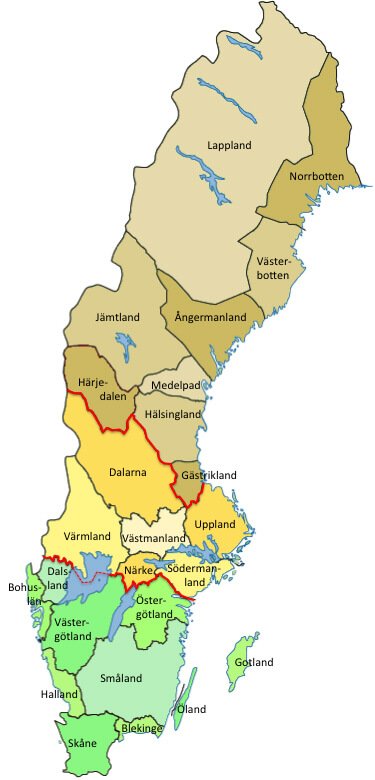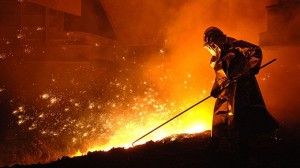An Overview Of Sweden
Geography of Sweden
Sweden is a rather small and oblong country in northern Europe, located on the same latitude as the state of Alaska (between map coordinates 69°3’N – 55°20N, which corresponds to the latitudes of the Alaskan cities of Nome and Ketchikan). The distance from north to south is 1,572 km (~977 mi), and the distance from east to west is about 400 km (~250 mi). This makes the area of Sweden slightly larger than that of the state of California (449,964 sq km ~ 173,731 sq mi).
Climate
Thanks to the Gulf Stream, which carries warm water from the Gulf of Mexico across the Atlantic Ocean, the Swedish climate is surprisingly mild; for instance, southern Sweden has warmer winters than the northern states in USA. Summer average high temperatures in the southern half of Sweden is 20-25 °C (68-77 °F).
Thanks to the high latitude, the length of daylight varies greatly; in the far north, you will experience midnight sun during part of the summer (i.e. the sun doesn’t set: for two months, the sun just keeps circling the firmament), and in the middle of winter, the sun won’t rise at all for almost two months…

Provinces and country parts
Sweden consists of three landsdelar or country parts, counting from south: Götaland, Svealand and Norrland. This division is an old tradition but is still used for referencing the respective areas, not only in the weather report.
In a finer division you’ll find 25 landskap or provinces – this partition dates from the Viking age and is really only historical. It has no judicial importance today, but it’s used in everyday language and is really the way people still think about Sweden.
The map at right shows the boundaries between the landsdelar/country parts, in the way that landskap/provinces belonging to
— Götaland are green,
— Svealand are yellow,
— Norrland are brown.
As you can see, it’s not correct to say, as some people believe, that everything north of Uppsala (under the second “p” in Uppland) is Norrland; e.g. people in Dalarna would be very offended indeed.
For administrative purposes, the country is divided into 21 län or counties. Many counties are more or less equivalent to a province, sometimes with the same name. Some of the counties are tightly working together, about to merge into regioner or regions.
On an even finer level, the counties are divided into 290 kommuner or municipalities.
Norrland: the Arctic region
Norrland (“the North Land”) covers almost 60% of Sweden’s total area, but is inhabited by only 12% of the people. In other words, it’s vast and sparsely populated. The reason for this is quite obvious: it’s cold, it’s dark, and it’s a great distance to anything.
A different and more positive view is that Norrland offers huge resources of iron ore, timber and hydroelectric power, plus vast areas of undisturbed alpine nature and wildlife with 24 hour daylight. It’s true that it takes a certain kind to live up there, but it’s very beautiful in many places. There are great possibilities for tourists: skiing, hiking, fishing, hunting, photo safaris, and it is also a big market opportunity for mosquito repellants.

The natural resources give Norrland a certain economical importance, but mining, forestry and waterpower have a fixed magnitude and does not promote expansion around the plants, why most of Norrland is characterized by stagnation and depopulation (which is why other provinces doesn’t want to be associated with Norrland). The exception from this is the string of small/medium-sized towns along the Baltic coast, with a few steel works, paper mills and smaller industries.
(Trivia: It’s commonly believed that people in Norrland are taciturn; maybe so, but I’ve seen/heard quite a few specimen that differ. A funny thing with the dialect is that in Norrland you say “jo” instead of “ja”. The word “ja” means agreeing “yes”, while, to the other 88% of the population, the word “jo” means opposing “yes”. And in Norrland, “jo” is pronounced as “choo”, but inhaling.)
Svealand, The Middle Kingdom
The name Svealand actually means the land of the Swedes. (The Swedish name for Sweden is Sverige, “the Swedes’ kingdom”, originally referring to what now is called Svealand.) Even if the northwestern part is wooded with a subarctic climate, Svealand also has areas of agricultural importance.
But most of all, Svealand is an industrial area, with mechanical industries in Karlstad (Metso paper processing machinery), Karlskoga (Bofors ordnance), Södertälje (Scania trucks) and Västerås (ABB robotics, power and automation). The area around the capitol, Stockholm, is also a center for telecom and IT industry and software developers.
Stockholm has been the capitol of Sweden since 1436 AD. The city itself has a population of about 1,400,000; with the surrounding urban area about 2 million. Most tourists will arrive to Sweden in ARN, Stockholm-Arlanda Airport.
The city of Stockholm, built on the islands in the inlet of lake Mälaren, offers a lot of interesting things for a foreign visitor, such as medieval architecture, museums, theatre, opera, exhibitions, royal castles, shopping, boat tours in the archipelago,…

My American friends, who visited a couple of years ago, fell in love with the huge and equable drumhorse Harry who, carrying the kettledrums, led the mounted life guards to the changing of the guards at the royal castle.
The southmost part, Götaland
Götaland (Gothia), means the land of the Goths (or Geats, as they were mentioned in the Beowulf epic).
Götaland has two major urban areas, Göteborg (Gothenburg), and Malmö (Malmoe), both highly industrialized.
Göteborg, with it’s big harbor, is often associated with Volvo cars and trucks, and a few miles to the north, in Trollhättan, you used to find the SAAB factory… now dormant with new owners that are planning to build electric cars there. The rocky coastline around Göteborg is highly treasured by foreign tourists as well as by Swedish boating people, but the local fishermen are still holding on to their trade in numerous small harbors.
Being a center for shipping, located just across the North Sea, Göteborg has always had strong ties to England, and still has.
Trivia: The connection to England can be observed by the fact that the first names “Glenn”, “Ronnie” and other English-sounding names, are fairly common in Göteborg but almost never used in other parts of the country :-).
People in Göteborg use to say that the west coast, where Göteborg is located, is Sweden’s front side; imagine what they say about the east coast (where Stockholm is)…
Across the country from Gothenburg is a rich agricultural area in the provinces of Västergötland, Östergötland, and Södermanland. In the Middle Ages, this was the heartland where the kingdom of Sweden was created.
Way down south lies the city of Malmö, the third city in size, administrative center for the county of Skåne (Scania). Situated on the south coast and connected with a bridge to the Danish capitol, Malmö and Copenhagen are in fact beginning to become one single urban area, straddling the border in the Öresund Strait. A few centuries ago, Skåne was actually part of Denmark. Malmö is surrounded by farmland; the soil in certain parts is classified to be among the best in Europe.
The nearby city of Lund has a cathedral from the 12th century, a university founded 1666 (with the original name “Regia Academia Carolina”), and is a center for scientific research.
The province of Skåne has a large number of castles, many of them open for visitors. Skåne has always been a rich part of the country, thanks to its rich soil and excellent location for trade with the rest of the European continent. The large number of castles bears evidence of the province’s wealthy past.
North of Skåne lies the province of Småland (which literally means “the little lands”), a highly industrialized area full of small industries, most notably the IKEA headquarters and origin.

Picture from svt.se
A little further north, the province of Östergötland (East Gothland, not to be confused with the island and province of Gotland) is another region of high-tech industrial and educational importance around the city of Linköping (SAAB military aircraft).